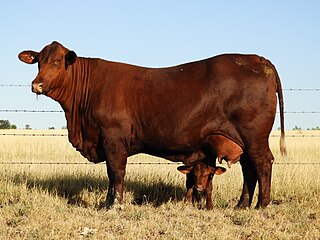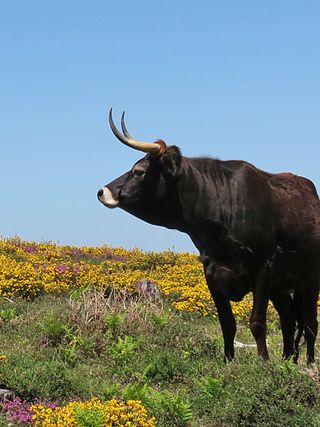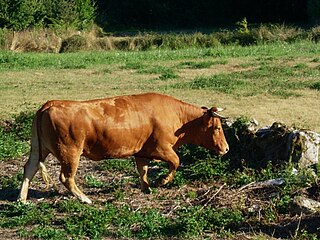
The Mangalarga Marchador is a Brazilian breed of riding horse. It is the national horse breed of Brazil, where there are more than half a million of them; it is among the most numerous breeds of riding horse in the world. It derives from cross-breeding of Portuguese Alter Real horses with local Criollo stock. It displays four gaits: the walk, the canter, and two ambling gaits, the marcha batida and the marcha picada; it does not trot.

The Garrano is a Portuguese breed of small horse. It is equivalent to the Faco Galego of Galicia in north-western Spain.

The Corriente is an American breed of small cattle, used principally for rodeo events. It derives from Criollo Mexicano stock, which in turn descends from Iberian cattle brought to the Americas by the Conquistadores, and introduced in the sixteenth and seventeenth centuries to various parts of what is now Mexico.

Nelore or Nellore cattle originated from Ongole Cattle cattle originally brought to Brazil from India. They are named after the district of Nellore in Andhra Pradesh state in India. The Nelore has a distinct large hump over the top of the shoulder and neck. They have long legs which help them to walk in water and when grazing. The Nelore can adapt to all except very cold climates. They are very resistant to high temperatures and have natural resistance to various parasites and diseases. Brazil is the largest breeder of Nelore. Nelore have the shortest ears of most Bos indicus types. There is a naturally polled strain of the breed.

The Santa Gertrudis is an American breed of beef cattle. It is a taurine-indicine hybrid breed, descended from both zebu and European cattle. It was bred in the early twentieth century in Texas, and received official recognition in 1940. It has been exported to many countries including Australia, Brazil and South Africa, and has contributed to the development of a number of modern breeds, among them the Barzona and the Droughtmaster.

The Gir or Gyr is an Indian breed of zebuine cattle. It originated in the Kathiawar peninsula in the state of Gujarat, and the name of the breed derives from that of the Gir Hills in that region. Other names include Bhodah, Desan, Gujarati, Kathiawari, Sorthi and Surti.

The Blonde d'Aquitaine is a modern French breed of large domestic beef cattle. It was created in 1962 by merging three blonde draught breeds of south-western France, the Blonde des Pyrénées, the Blonde de Quercy and the Garonnaise. Since about 1970, it has been selectively bred specifically for beef production. It is the third-most numerous beef breed of France, after the Charolais and the Limousin. It has been exported to many countries round the world.

The Red Sindhi is a dairy breed of zebuine cattle. It is believed to originate in western Sindh and in the Las Bela area of Balochistan, now in Pakistan. It is widely kept in Pakistan, where in 2006 there were approximately 3000000 head; there are small numbers in India and in Bangladesh. Other names include Las Bela, Malir and Sindhi.
The Indu-Brasil or Indo-Brazilian is a Brazilian breed of zebuine beef cattle. It was bred in the early twentieth century in the Triângulo Mineiro in the western part of Minas Gerais state, and particularly in the area surrounding Uberaba. It was originally known as the Induberaba. It derives from imported Indian zebuine cattle, principally Gir and Kankrej. It was formerly an important beef breed, but in the twenty-first century is an endangered breed. It is characterised by particularly large ears, perhaps the largest seen in any breed of cattle.

The Droughtmaster is an Australian breed of beef cattle. It was developed from about 1915 in North Queensland by crossing zebuine cattle with cattle of British origin, principally the Beef Shorthorn. It was the first Australian taurindicine hybrid breed; it is approximately 50% Bos indicus and 50% Bos taurus.
The Pantaneiro is a cattle breed from the Pantanal region of Brazil, where it has been raised for more than three hundred years. It is now considered to be at risk of extinction.
Crioulo Lageano longhorn beef cattle originated from cattle originally brought to Brazil from Portugal by the Jesuits 400 years ago. The breed was probably domesticated 4000 BC in Egypt, it came to the south of Spain from the North of Africa. The center of the rest population is the plateau of Lages, Santa Catarina, Brazil.

The Maronesa is a traditional Portuguese breed of mountain cattle. Its name derives from that of the Serra do Marão, which lies in the Trás-os-Montes and Douro Litoral regions in the northern part of the country. Its primary use is for draught power.

The Minhota or Galega is a Portuguese breed of cattle. It is reared principally for beef; in the past it was used also as a draught beast and for milk.

The Mirandesa is a Portuguese breed of beef cattle. It originates in – and is named for – the Terra de Miranda, the area of north-eastern Portugal where Mirandese is spoken, particularly the municipality of Miranda do Douro. It was formerly used as a draught animal, and was distributed throughout almost all of the country. It is now reared for beef; the meat may be marketed as Denominação de Origem Controlada.
The Campeiro is a breed of small horse from Brazil. It is thought to descend from horses brought to South America in the sixteenth century. Because it has an ambling gait and comes from the area of the Araucária forests of southern Brazil, it may also be known as the Marchador das Araucárias.

The Nordestino, also known as Crioulo Nordestino, Mourão, Pé Duro Nordestino or Sertanejo do Nordeste, is a breed of horses native to the Northeast Region of Brazil. The breed is near extinction due to the lack of interest in maintaining it. A stud-book was created and approved in 1987 by the Brazilian government; nevertheless in 2017 the authorization to carry out the genealogical records of the breed was revoked by the Ministry of Agriculture causing the loss of the breed's lines records. It is the first native horse breed of Brazil, and derived from the first horses brought by Portuguese settlers in the sixteenth century. Over time the horses have evolved into a small breed very well-adapted to surviving in the local semi-arid climate of the Northeast Region. Today around 500,000 horses survive in the region pulling horse carts or in cattle work.

The Lavradeiro or Wild Horse of Roraima is a Brazilian breed or population of feral horses of Colonial Spanish type in the state of Roraima, in northern Brazil. The name derives from the lavrado or savannah terrain in that region.
The Criollo Mexicano is a Mexican breed or group of breeds of Criollo cattle – that is, cattle that derive principally from the Iberian cattle brought to the Americas by the Conquistadores from the time of the Second Voyage of Christopher Columbus in 1493.














